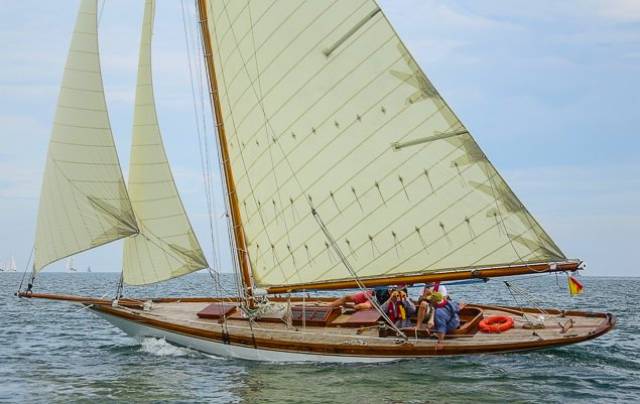In his poem Sailing to Byzantium (1928), William Butler Yeats immortalised the vision of Ireland as “no country for old men”. Expressed so well, the idea took hold and has been re-used internationally in novels and films, even if in Ireland itself some of our most influential decision makers – or perhaps more accurately decision-deferrers - were long past any official retirement age, making Ireland seem the ideal place for old men.
Yet for many ordinary folk, Ireland was certainly no country for old men – or women. Indeed, in the 1950s it had degenerated into somewhere that was no country for almost everyone. In today’s nearly-too-vibrant Ireland, it is difficult to visualize such a state of affairs. But it existed, even if now we live in a frenetic era in which Ireland seems to be playing a key role in the invention of new products in many areas of research and manufacture, with regular access to something fresh and completely new regarded as a birthright, whether we like it or not.
But surely we all like fresh and new products? Well, maybe in some areas of life we do. But in sailing, we really do seem to be in a place which is no country for new boats. We’ve an almost unhealthy veneration for old, traditional and classic craft. And if we accept that no-one is a hypocrite in their pleasures, then that’s the way it genuinely is. W M Nixon reflects on a central aspect of Irish sailing.
Originally, this was going to be a piece on how to cope with the enthusiasm of the incoming administrators of the Volvo Dun Laoghaire Regatta for the success, in 2017’s event, of the newly-introduced Classics and Traditional Class racing for the Kingstown 200 Trophy to celebrate the Bicentenary of the harbour.
 Boats of all kinds at the end of the day’s racing in the Volvo Dun Laoghaire Regatta 2017, with the engine-less classic Myfanwy on tow between cruiser-racers in the foreground, and Mermaids and Flying Fifteens beyond. Photo: W M Nixon
Boats of all kinds at the end of the day’s racing in the Volvo Dun Laoghaire Regatta 2017, with the engine-less classic Myfanwy on tow between cruiser-racers in the foreground, and Mermaids and Flying Fifteens beyond. Photo: W M Nixon
 “Sundry boats” – the slip at the NYC with Flying Fifteens, a Wayfarer, International 420s, a classic Royal Anglesey Fife OD, and cruiser-racers beyond Photo: W M Nixon
“Sundry boats” – the slip at the NYC with Flying Fifteens, a Wayfarer, International 420s, a classic Royal Anglesey Fife OD, and cruiser-racers beyond Photo: W M Nixon
 Somehow there was a way through for everyone, but patience was required. Photo: W M Nixon
Somehow there was a way through for everyone, but patience was required. Photo: W M Nixon
After the conclusion of VDLR 2017, in his first statement as the new Regatta Chairman, Don O’Dowd expressed the hope that the Golden Oldies – berthed in their special area off the National Yacht Club and highly visible to other competitors and the public alike – would become a regular feature in future stagings of the mighty biennial urban sailfest.
That caused a certain intake of breath here in SailSat Towers. We were peripherally involved in hunting down some of the more exotic and remotely-located classics, and persuading them to come to Dun Laoghaire for early July 2017. But it was done with a certain dogged enthusiasm, for we were reassured that this would be a one-off, and the suggestion was that it wouldn’t be repeated in future years. That was fine by us, as it was all just about as easy as herding cats at a cross-roads.
Then, when it all got started, the weather was perfect, mostly summery southeast round to nor’west breezes, offshore winds for the most part. Thus that temporary long pontoon over towards the Carlisle Pier, which was the making of it all, remained well sheltered, yet it would have had to be vacated pronto if strong onshore nor’easters arrived.
 Ideally gentle conditions for a crowded event with in-harbour finishes – a Colleen and the 1894-vintage Peggy Bawn, to which owner Hal Sis had fitted a set of cotton sails originally preserved by longtime owner James McAsey. Photo: W M Nixon
Ideally gentle conditions for a crowded event with in-harbour finishes – a Colleen and the 1894-vintage Peggy Bawn, to which owner Hal Sis had fitted a set of cotton sails originally preserved by longtime owner James McAsey. Photo: W M Nixon
A crazy idea we’d come up with – back in the March 25th 2017 Afloat.ie, but we’d been plugging it before then – was that in the absence of any commercial shipping, there should be in-harbour finishes for selected classes as another part of the Kingstown 200 celebrations.
But decision-maker Con Murphy acted quicker than anyone expected. He made all keelboat finishes in the harbour - and on a short line at that - and it reached its apotheosis on the Saturday, when a summery south to southeast blew gentle and warm. The East Pier became a peninsula which was a shore part of the course, as a weather mark well into Sandycove/Scotsmans Bay brought a very mixed fleet together for the run down to the end of the East Pier, then they’d to tack up the harbour to the finish in towards the National YC, and the regatta atmosphere was total.
Yet had there been foul onshore weather, this scenario would have been impossible, even if racing of some sort could have been arranged. So in looking back at the experience with the Kingstown 200 Classics, there’s an impulse to say that we were lucky, we mightn’t be so lucky in 2019, so let’s make it a one-off, celebrate what was achieved, and leave it at that. After all, a Bicentenary only occurs just the once.
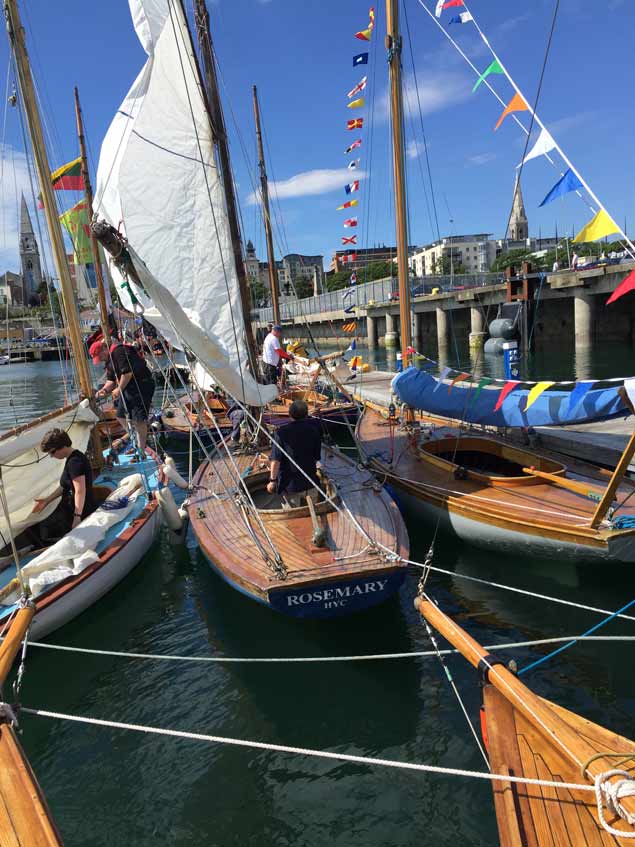 Anarchists from across the bay – Howth Seventeens (founded 1898) at the Classics Pontoon in Dun Laoghaire. Photo: Ian Malcolm
Anarchists from across the bay – Howth Seventeens (founded 1898) at the Classics Pontoon in Dun Laoghaire. Photo: Ian Malcolm
But now there are those from elsewhere who say that if they’d only known how good it was going to be, then they’d have come too. Yet perhaps most tellingly of all, there was the response from people doing the regatta in modern boats. Despite regularly sailing in the place, they hadn’t been fully aware of Dun Laoghaire’s extraordinary sailing history, and a heritage which would have been almost lost were it not for the Water Wags.
They happily now go from strength to strength, with a good chance that next Wednesday evening’s racing for the Captain’s Prizes (Hal Sisk is current captain) will see the turnout top the 30 mark for the first time since the “new” Wag design was introduced in 1900.
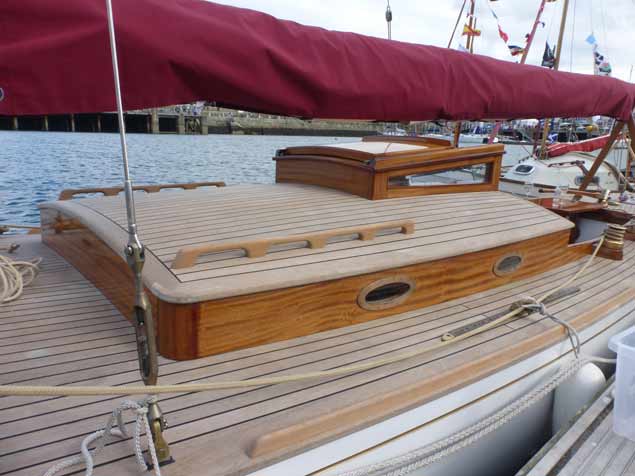 The re-born Dublin Bay 24 Periwinkle had some of the finest woodwork we’ve ever seen. Photo: W M Nixon
The re-born Dublin Bay 24 Periwinkle had some of the finest woodwork we’ve ever seen. Photo: W M Nixon
And back at Kingstown 200 in July, the restored Dublin Bay 24 Periwinkle turned up to wow everyone, and now there’s a fairly reliable whisper that a re-born version of the Dublin Bay 21s will appear next year. As for the assorted classics and traditional boats which did appear in 2017, seeing them as a little fleet had an impressive effect, and any increase in numbers will improve only improve that impression.
So old boats – and the more classic the better – are all the rage. And it’s not just limited to wooden boats. This week in Afloat.ie, it seemed perfectly normal that former Olympic sailor and four times Irish Helmsmans Champion Mark Mansfield of Cork should be writing very informatively and with enthusiasm about the classic Half Tonners at Kinsale. The great man is undoubtedly very into this class. Yet what he has been doing is writing about how you might best optimise the racing in boats which are thirty years old and more, and all of them from a former development class in which the newest boats were generally the fastest.
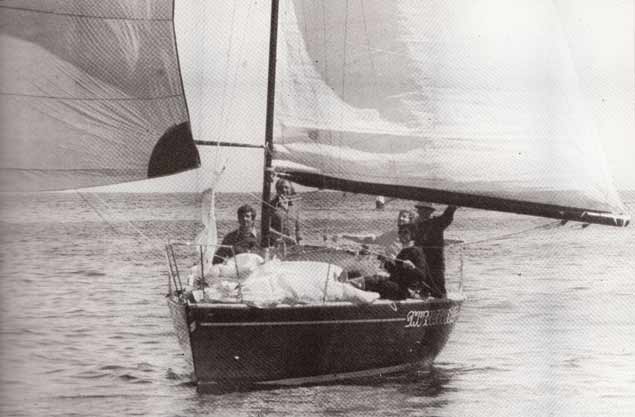 Swuzzlebubble in Bruce Lyster’s ownership in 1980, coming in to the finish of the Pwllheli to Howth race to win, and win the Irish Sea ORA Championship too, with Bruce Lyster (left) Robert dix on helm and Drewry Pearson and Des Cummins on right. Photo: W M Nixon
Swuzzlebubble in Bruce Lyster’s ownership in 1980, coming in to the finish of the Pwllheli to Howth race to win, and win the Irish Sea ORA Championship too, with Bruce Lyster (left) Robert dix on helm and Drewry Pearson and Des Cummins on right. Photo: W M Nixon
For anyone who would deny the Half Tonners classic status, I would defy you not to look at the gloriously individualistic and all-conquering Swuzzlebbble, and not be moved. I fell for her when Bruce Lyster first brought her to Ireland in the late 1970s. Since then, there has been the fairy story of how she was saved when just about to be dumped on a landfill in Greece. And now she is faced with having to get her rating down by 0.25 points if she is to stay within the proposed new Half Tonner rating band.
 The restored Swuzzlebubble at Kinsale. Photo: Robert Bateman
The restored Swuzzlebubble at Kinsale. Photo: Robert Bateman
Let’s hope it is an Irish owner who takes on this worthy challenge. But involvement at this level is not for the financially-challenged. Yet in looking at today’s Irish racing fleet of all sizes, the abiding impression is of a lack of totally new boats. The wounds of the financial crash have not yet full healed, and they may never heal in some cases. But there’s no doubting the fact that we’ve become very adept at sniffing out deals in second-hand boats, and with the huge slightly-used boat cornucopias so accessible in the south of England and France, it’s a happy hunting ground.
Thus of the current Queens of the Fleet in Dublin Bay, the thriving J/109 Class, only one or at most two were bought new. Before that, second-hand boats were the case with the rapid expansion of the Sigma 33 class. And across the bay and beyond the headland in Howth, the J/80 class continues to strengthen thanks to a ready second-hand supply which always grows towards Autumn, for simply keeping a boat in the main French and English sailing centres through the winter months can be one very expensive little hobby.
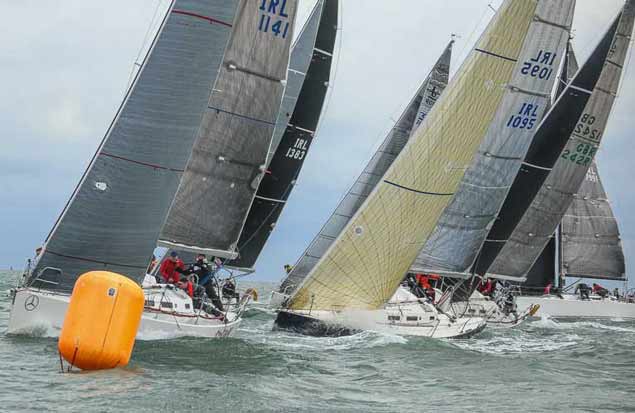 The J/109 Class in Dublin Bay Photo: Afloat.ie
The J/109 Class in Dublin Bay Photo: Afloat.ie
Of course, there’ll always be those who hanker after the unique feeling of a brand new boat, and who want to be at the cutting edge of development. But with Dublin Bay and Cork Harbour’s special combination of a reasonably affluent population within easy reach of good racing waters, there’s great value to be had either in acceptance of the limitations imposed by the One-Design discipline, or the patient optimising of an older boat to maximize her rating advantage for handicap racing.
The problem is that as the years pass and the second-hand boats coming on stream for modification possibilities become more technically advanced in their construction, we move from the world of the skilled amateur to the competent and much-in-demand professional. Thus the less affluent boat owners with some DIY capabilities find their options becoming more limited, and they seek an outlet for their talents and limited resources in older craft with comprehensible technologies.
 The 1895 Manx longliner Master Frank – bought derelict for £1, and self-restored by Joe Pennington And some are attracted to very old craft indeed, and often for historical reasons. Thus although in Dun Laoghaire we were bowled over by the sheer quality of the re-born DB 24 Periwinkle, there was no doubting it was a professional job of the highest calibre. So at a human level, it was much easier to be attracted to Joe Pennington’s restored 1895 Manx longliner Master Frank, for he restored her himself after buying her from the dithering Isle of Man government for £1 after an impassioned plea – while still wearing his working clothes as a carpenter – from the floor of the House of Keys in Douglas.
The 1895 Manx longliner Master Frank – bought derelict for £1, and self-restored by Joe Pennington And some are attracted to very old craft indeed, and often for historical reasons. Thus although in Dun Laoghaire we were bowled over by the sheer quality of the re-born DB 24 Periwinkle, there was no doubting it was a professional job of the highest calibre. So at a human level, it was much easier to be attracted to Joe Pennington’s restored 1895 Manx longliner Master Frank, for he restored her himself after buying her from the dithering Isle of Man government for £1 after an impassioned plea – while still wearing his working clothes as a carpenter – from the floor of the House of Keys in Douglas.
Then there was another star of the show, Rob Mason’s 1897-built Myfanwy from Milford Haven, self-restored and a very timely reminder in Dublin Bay of the largely-forgotten Liverpool naval architect Alexander Richardson, who was the toast of Kingstown Harbour back in 1884 when he created the design for John Jameson’s all-conquering cutter Irex.
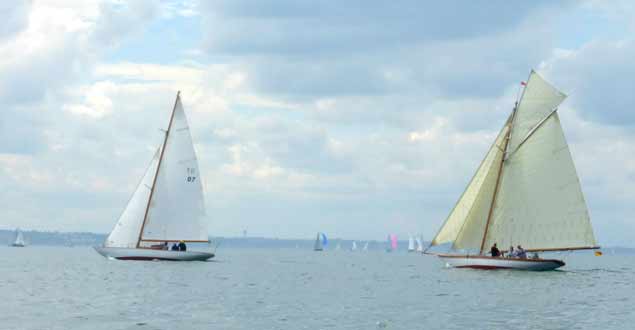 The originally-1947 DB 24 Periwinkle, with the 1897 Myfanwy giving her a run for her money. Photo: W M Nixon
The originally-1947 DB 24 Periwinkle, with the 1897 Myfanwy giving her a run for her money. Photo: W M Nixon
You feel you’re in touch with a deeper reality when you’re in the company of guys who have done their own major restorations and maintenance jobs, and one of my most memorable evenings was at the Peel Traditional Boat Festival in the Isle of Man a couple of years ago, when the mood was vibrant with the presence of Joe Pennington, Dickie Gomes, and Adrian Spence, who between them kept characterful boats of age total 361 years merrily sailing the seas.
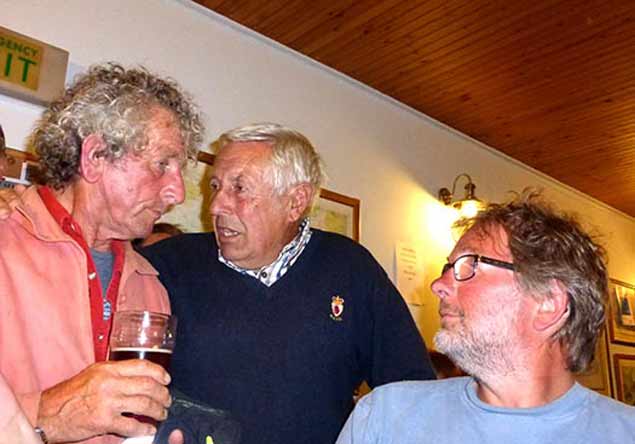 Joe Pennington, Dickie Gomes and Adrian Spence in the Isle of Man a couple of years ago, and full of opinions. At the time, the total combined age of their three boats was 361 years, Photo: W M Nixon
Joe Pennington, Dickie Gomes and Adrian Spence in the Isle of Man a couple of years ago, and full of opinions. At the time, the total combined age of their three boats was 361 years, Photo: W M Nixon
As a boat bodger of decades of experience, I can usually trade horror stories with the best of them, and indeed have shared some special moments – I was once hurled right across a shed in company with Dickie Gomes one winter’s night, when we were trying to fit a replacement plank in round the curve of the counter in Ainmara, and the replacement plank – of vintage salvaged pitchpine to match the timber in the boat – decided it preferred its lifelong straight shape.
The same can-do approach was evident in Rob Mason of Myfanwy. After the article about his mostly single-handed restoration of her appeared in Classic Boat magazine, we sent him off an email towards Christmas suggesting that as he was just across the channel, albeit in the long southeasterly direction in Milford Haven, he might like to bring Myfanwy to Dun Laoghaire.
 Invitation accepted from Australia…Myfanwy berthed inside Peggy Bawn in Dun Laoghaire, after owner Rob Mason had accepted the invitation to come with persuasion from his son Max in Australia. Photo: W M Nixon
Invitation accepted from Australia…Myfanwy berthed inside Peggy Bawn in Dun Laoghaire, after owner Rob Mason had accepted the invitation to come with persuasion from his son Max in Australia. Photo: W M Nixon
The email found him in Australia on holiday with his son Max, and when Max heard about it, he said he’d come home for a holiday to race Myfanwy on Dublin Bay for the Kingstown 200. So with mates Andy Whitcher and Gus Stott, they brought Myfanwy across and sailed so fast with her that the Progressive ECHO system proved to be the Aggressive ECHO for the team from Milford haven. They ended racing with a handicap nearly as high as Periwinkle, which seemed absurd, as Periwinkle won overall yet Myfanwy seldom got near the podium.
It seemed to me to be rather a weird sort of hospitality to be extending to such a special visitors, but the Myfanwy lads weren’t in the least bit fazed by it, in fact they were having a ball. And in bantering with them on the club balcony, I got to talking with Rob about how, in some jobs with restoring boats, you have no option but to do some risky undertaking with an angle grinder, which in a confined space can become a lethal weapon.
I showed him a now-faint scar across my thumb, a scar which looked quite a mess when it was fresh, while the thumb didn’t really deserve to be still attached to the hand at all. But the great restorer of Myfanwy put me in my place. Rob simply hauled up his T-shirt, and there on his midriff was the unmistakable imprint of an angle-grinder, but now so neat it’s like a tattoo. These are the kind of people who keep the really interesting old boats going.
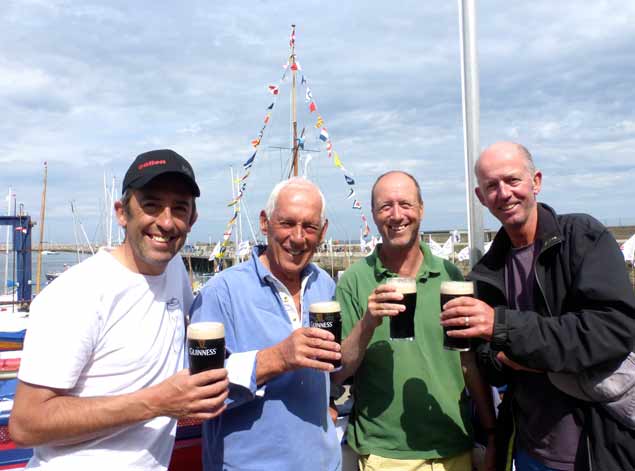 Classic people and classic celebration (left to right)– Max Mason, his father Rob Mason who restored Myfanwy, Andy Whitcher and Gus Stott. Photo: W M Nixon
Classic people and classic celebration (left to right)– Max Mason, his father Rob Mason who restored Myfanwy, Andy Whitcher and Gus Stott. Photo: W M Nixon




























